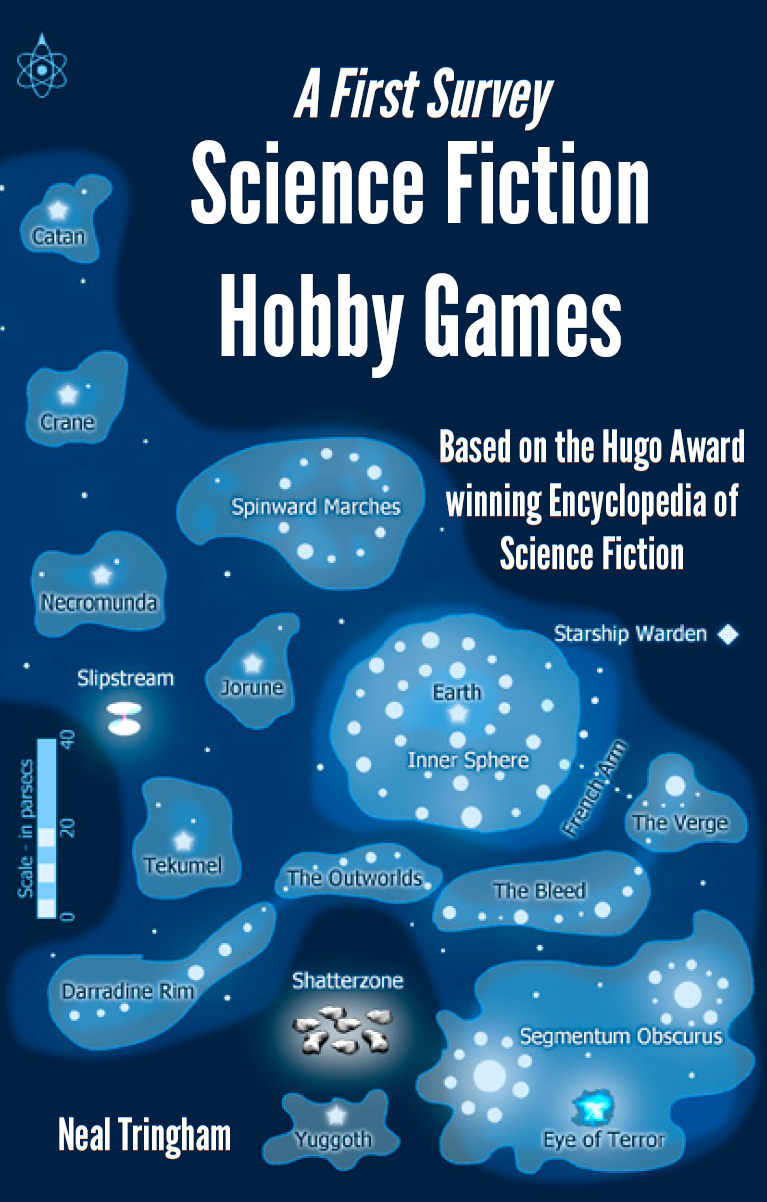Science Fiction Hobby Games: A First Survey
This article originally appeared in the August 2013 issue.
 Science
Fiction Hobby Games: A First Survey. Neal Tringham.
Science
Fiction Hobby Games: A First Survey. Neal Tringham.
Pseudonymz http://www.pseudonymz.com/
354pp., multiple formats
hardback: UKú24.99/US$39.99
paperback: UKú15.99/US$24.99
eBook (PDF, Kindle, ePub): UKú6.99/US$9.99
I’d first like to extend my thanks to Neal Tringham and Pseudonymz for the complimentary copy of this work that they provided for this review.
In subtitling this work “A First Survey”, the author does in fact tell you what you are getting: most of the three-hundred-plus pages are encyclopedic summaries of the publication histories and default settings of over a hundred science-fiction games, covering such widely differing formats as role-playing games, wargames, board games, card games, postal games, and gamebooks.
In addition to the game summaries, there is about thirty pages of introductory matter, explaining what the book is and how to read it; another twenty-five or so of glossary; a five-page bibliography; and about fifteen pages of index.
The author sets out his purpose and approach in the Foreword; these can be summarized by two phrases from it: “This book is … devoted mainly to critical analysis of the works and traditions it considers…” and “…this book is primarily concerned with hobby games as works of science fiction rather than as games…”. The rest of the Foreword elaborates on those two phrases and sets out the structure of the book.
Following the Foreword is a section on the conventions used in the book. This section is perhaps over-written, but it is hard to criticize the author for wanting to make sure that his writing is understood. The biggest flaw is that it’s somewhat repetitious; there is no reason, for example, that the specific descriptions of the entries for novels, gamebooks, anthologies, and nonfiction could not have been folded into a single description.
A section titled “Hobby Games and Science Fiction” begins the book proper (that is, it begins the discussion of the subject matter of the book, rather than discussing the book itself). An overview of the historical relationship between games and science fiction is presented, leading to a supposed bifurcation into “hobby games” such as the author focuses on in this volume, and digital computer games. It is here that I find a flaw; while text adventures such as Crowther and Woods’ “Adventure”/“Colossal Cave”, or Infocom’s Zork series (or, more relevantly to this work, “Planetfall”) are definitely “computer games”, they are, in my view, no less “hobby games” than the ‘Choose Your Own Adventure’ books that the author explicitly includes in the encyclopedic section. If one were to look at the history of the text adventure/“Interactive Fiction”, it arguably follows that of “hobby games” more closely than it does the rest of the computer game industry.
The next section is titled “Game Worlds”, and discusses how the world—what is often called the “setting”—influences the play of the game, and how the needs of the game (most notably, the need for some degree of balance between the players and their in-game antagonists) affect the setting.
The next section, “Game Stories”, discusses the various structures that a game story—what in the RPG world is generally called an “adventure” or a “campaign”—can take on. The author identifies a surprising number of different models, but in the description of each, mananges to justify the separation. While the examples given tend to suggest that certain structures are more prevalent in certain game formats, there is no hard linkage between them, and enough examples and discussion to suggest that virtually any of the story structures can occur in almost any game format.
Following this is the encyclopedic reference section. This is divided by format (e.g., Role Playing Games, Gamebooks, Board Games, etc.), and each section begins with an introductory description of the essential characteristics of the game format, along with discussion of the history of and specific general developments for the format (for example, GNS theory (which the author refers to as “GDS theory”, substituting “Drama” for “Narrative”) in the section on Role Playing Games). In many ways, these introductory sections are the most interesting parts of the book, and it can be argued that they are the most important—they provide context for the entries for the specific games that the author looks at. It should be noted that some of the “specific game” entries are actually settings for games or campaigns (for example, TÚkumel has its own entry). Some of the decisions made in this section might be questioned; for example, there is no mention of the FATE or FUDGE systems in the introductory matter for Role Playing Games, though Starblazer Adventures has an entry—but Diaspora does not. In the Gamebooks section, there is some discussion of Choose Your Own Adventure, and the similar Crossroads Adventures, in the introductory matter, but only CYOA is specifically discussed in its own entry, without mention in the entry of the other essentially identical lines from other publishers, or giving those other lines their own entries. These flaws don’t detract from the ultimate interest and value of the work as a whole, however.
Overall, the ebook is certainly worth its price, and I doubt I’d turn down the paperback at the listed price. Neal has done a very credible job, and anyone who found Shannon Appelcline’s Designers and Dungeons (which is named in the bibliography of this book) of interest should put a copy of this book right next to it.
 Freelance
Traveller
Freelance
Traveller